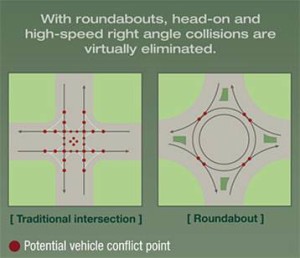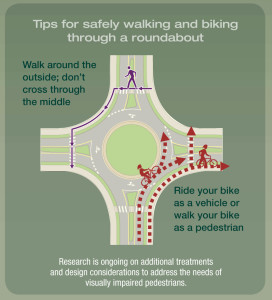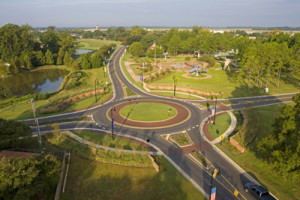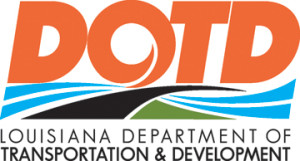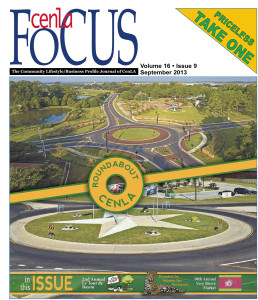
One of the most basic questions people ask is, “Just what is a roundabout?” In a roundabout, traffic flows counterclockwise through a center island. At a roundabout, a vehicle must slow down and yield to enter. Unlike traffic lights or stop signs, the vehicle does not stop. Instead, the roundabout is built to ensure that travelers maintain a slow speed, and those entering can do so safely. This reduces the chances of a dangerous “T-bone” type accident, which sometimes occurs at a stop light or stop sign without the benefit of an angled entry point. Stop-and-go traffic is eliminated at a roundabout because travelers are constantly moving through the intersection.
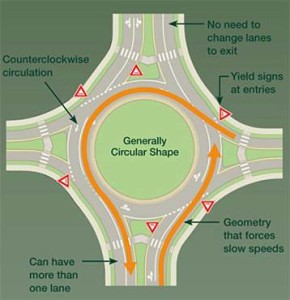
One of the most famous (or infamous) traffic features in Cenla is Alexandria’s south traffic circle. Although roundabouts and traffic circles are similar in shape, their functionality varies greatly. The new, modern roundabouts differ in how they operate and are designed. Rotaries and traffic circles are typically much larger than the modern roundabout. The compactness of a modern roundabout helps keep speeds low and makes it easier for drivers to stay oriented and judge the speed of the vehicles before entering the roundabout. Modern roundabouts require traffic to yield, not merge in order to enter and exit. Conversely, the Alexandria south traffic circle, for example, requires traffic on the inner lane to merge into the outermost lane in order to exit, creating additional potential conflict points which are greatly reduced by design in a modern roundabout.
Roundabouts help to improve and eliminate more severe crashes. “At DOTD, we strive to ensure safety for the traveling public by focusing on transportation projects that improve major corridors, traffic congestion and road quality,” said DOTD Secretary Sherri H. LeBas. “The implementation of roundabouts across the state is another great example of an innovative commitment to safety.”
“Statistics show that roundabouts are safer by a significant margin,” Alexandria Public Information Officer Cynthia D. Jardon said. “The roundabouts are a state project, which is part of a bigger federal program to make streets safer. The roundabouts slow traffic and help curb serious collisions.” According to the Federal Highway Administration, roundabouts save lives by:
• Reducing fatalities by up to 90%
• Reducing injury crashes up to 76%
• Reducing pedestrian crashes up to 30% to 40%
• Creating up to 75% fewer conflict points than a four-way intersection. Conflict points are any point where the paths of two through or turning vehicles diverge, merge or cross.
Roundabouts also provide several positive economic advantages over more traditional signaled intersections. Because roundabouts require no signal equipment, the costs of installation and repair is eliminated. As a result, road electricity and maintenance costs are reduced by an average of $5,000 per year. The savings are further enhanced through longevity, as roundabouts provide a 25-year service life as compared to the ten-year expected service life of signal equipment. The positive economic impacts extend beyond state budgets to consumer pocketbooks. Fewer stops and hard accelerations mean less time idling when compared with signalized intersections, thus decreasing fuel consumption. In this way, roundabouts also provide environmental benefits by reducing vehicle delay and carbon emissions. Fewer stops and less acceleration is good for traffic flow, better for your car and safer for travelers.
The first roundabout DOTD constructed is located at the intersection of Louisiana Highway 93 and Ridge Road in Lafayette. It opened to traffic in September, 2003. DOTD has developed more roundabout projects designed to increase safety and improve traffic flow across the state. DOTD currently has roundabouts in the Abita Springs, Lafayette, Leesville, New Orleans, Port Vincent and Slidell areas.
Two of the most notable Cenla roundabouts currently in operation are located at England Airpark in Alexandria and at the intersection of US Highway 171 and Louisiana Highways 8 and 28 in Leesville, with a major new installation slated for the intersection of Jackson Street, Twin Bridges Road, Horseshoe Drive and Lodi Road in Alexandria.
The redevelopment of England Airpark from the closed England Air Force Base required innovative problem solving, creative thinking and demanding project execution. From welcoming Union Tank Car, to creating an Audubon Trail Golf Course through a contaminated urban landscape, and clearing and constructing the signature James L. Meyer Commercial Terminal, England Airpark has addressed each challenge with effectiveness, efficiency and world class design. The intersection of Vandenburg Drive and England Drive, a critical choke point, posed a significant challenge in traffic management and safety.
England Airpark fundamentally believes in master planning the changes to the campus. The latest master plan, which can be found at www.englandairpark.org, called for the construction of two roundabouts. The England Authority Board of Commissioners worked with staff and professional traffic engineers to understand the “modern roundabout” and its benefit if properly executed. When opened, the England Airpark roundabout increased traffic safety, flow and stability. With the surrounding fountains, the roundabout became a point of interest on the campus complimenting the stunning architecture of the James L. Meyer Terminal.

DOTD hopes to bring similar positive results to a major intersection in Alexandria. “The state has plans to install a roundabout at the intersection of Jackson Street Extension (which is Louisiana Highway 1208), Twin Bridges Road, Horseshoe Drive and Lodi Road,” according to Alexandria Mayor Jacques M. Roy. “There is no question that this intersection is congested and hazardous to cross. It is a prime location for a roundabout. It should not only improve safety but also help move traffic more efficiently.” The plan, set for opening in 2015, has met with a measure of skepticism for residents who harbor very mixed emotions based on their experiences with the older traffic circles. Greater understanding of the benefits of the modern roundabout help address some of these concerns and has turned apprehension into excitement. “The City of Alexandria is not in charge of roundabouts installed on state roads and highways, although our input is key to state stakeholders and would be considered. I’ve watched big suspicion turn to ‘when are we getting it?’,” explains Roy. With all the potential benefits, it’s easy to understand the growing excitement.
“Roundabouts makes sense. All the traffic makes the same right turns around the circle and exits as vehicles get to the desired street. It’s hard to have a head-on crash if all the vehicles are going the same direction,” Jardon said. While the economic impacts and environmental benefits are great bonuses, in the end, for everyone involved—from DOTD to elected officials to everyday travelers—the most important function of infrastructure upgrades is safety. “I am in favor of anything that helps protect our citizens so they might live injury-free lives,” Roy said.
Editor’s Note: Cenla Focus would like to gratefully acknowledge the contributions of Deidra Druilhet, Murphy LeDoux, Jr., Jonathan Lachney, Michael DeSelle, Jon Grafton, the Louisiana Department of Transportation and Development, the England Authority and the City of Alexandria for their contributions to this story.

